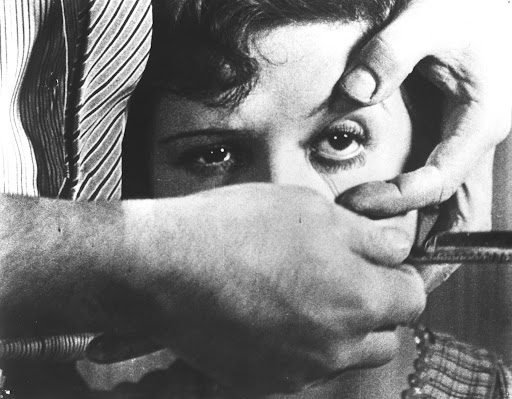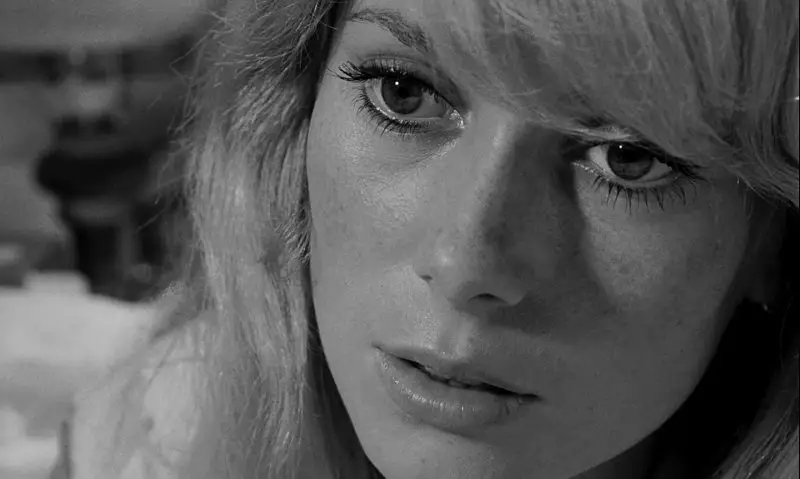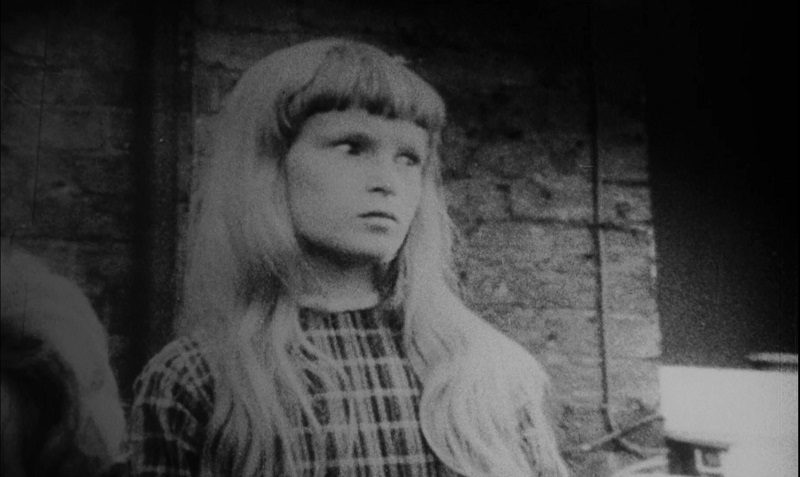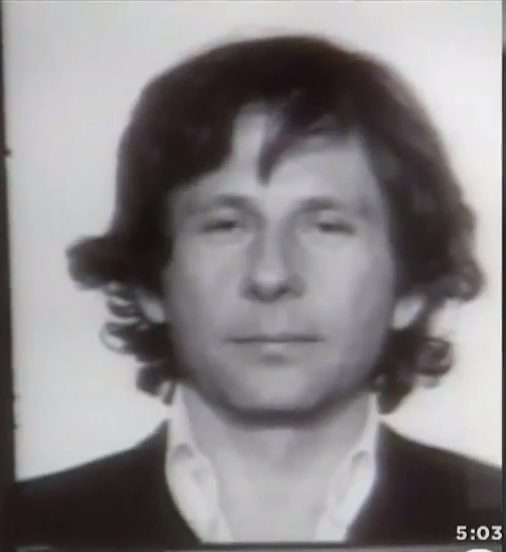Before he was known as the hotshot director of Rosemary’s Baby, the widower to tragic Manson family murder victim Sharon Tate, or the controversial director-actor who made Chinatown a neo-noir New Hollywood classic, and long before conviction on a rape charge led to his exile from Hollywood, Roman Polanski’s was a name untainted by scandal. He was, in the mid-1960s, a promising young Polish talent whose first film, Knife in the Water, earned him acclaim and opportunity that led him to Great Britain, where he would direct his first English-language film. His next, Repulsion, a claustrophobic work of psychological horror set in a shabbily realistic kitchen-sink milieu, employs the tenets of surrealism to chart its protagonist’s uncanny descent into hallucination and violence.
Since surrealism is not a genre with which one would normally associate Polanski – whose filmmaking tends, even in narratives dealing with the fantastic. towards a dark and even morbid realism – a bit of context may be helpful. While poets and painters largely established the form in the aftermath of World War I, filmmakers soon found in surrealism a viable means of evoking and communicating the subconscious. As an art form, cinema is inextricably linked with psychology, both nascent in the late 19th century and coming to fruition early in the 20th Century. Cinema, it has often been said, is the most dreamlike of all art forms, its oneiric qualities inherent in both what it conveys and in how it is received. If psychology aimed to understand the subconscious, then cinema could hope to render it.

Surrealist cinema in its purest form is best represented by the Luis Buñuel-Salvador Dali collaboration Un Chien Andalou, the 1929 short that featured ant-strewn and severed appendages, slain donkeys, religious symbols, and a razor-sliced eyeball in a witches’ brew of non-sequiturs and troubling imagery. But even earlier, the clever hi-jinks of George Méliès’ trick films employed similar techniques to evoke dreamlike imagery where one reality could instantaneously replace another through the magic of the simple cut. Experimentalists like Man Ray later fashioned enigmatic montages of gyrating objects, urban images, and human forms in abstractions that would resemble surrealism’s dreamlike states. French directors Jean Vigo and Jean Cocteau both would employ surrealist imagery in the service of more traditional narratives, their flights of fancy lending a dreamlike feel to key moments in Zero de Conduite and La Belle et la Bête.
By the time of the Buñuel-Dali collaboration, surrealism was well established in poetry and painting, as a rejection of rationalism that evoked the subconscious. In a sense it aimed for a kind of anti-art. But its techniques could also be used, as Vigo and Cocteau in particular proved, especially effectively in the context of a more logical, causal narrative, especially to evoke a sense of Freud’s uncanny: that which may seem on the surface familiar but could be depicted in cinema in ways that would evoke a sense of the surreal.
Repulsion, a film set in the mundane kitchen-sink realism of the British cinema of the 1960s, employs those very conceits effectively: in a narrative that functions in an entirely realistic, plausible, lower-middle-class world, several brief, intense, and surprising episodes surrealistically convey the increasingly fraught and ultimately frightening perspective of its protagonist.

Deneuve plays Carol Ledoux, an introverted young woman whose isolation and inhibition begin to wreak havoc for her friends and paramours. Her particular case, what some have called androphobia, develops as a pathological fear of interaction with men. A Belgian manicurist who lives in a London flat with her sister Helen (Yvonne Furneaux), Carol can barely tolerate the visits from Helen’s married boyfriend Michael (Ian Hendry). She is repulsed by the sounds of the two having sex through their flat’s thin walls and the presence of Michael’s toiletries in their bathroom—including his leaving his used straight razor in her rinsing glass.
These moments of repulsion continue to accumulate with each of Carol’s encounters with men. When Helen and Michael leave on an Italian holiday weekend, Carol withdraws further and further into isolation, rejecting advances from prospective paramour Colin (John Fraser). Eventually barricading herself in her apartment, she experiences a series of increasingly harrowing hallucinations as she descends into a madness made palpable by Polanski’s use of surrealist technique.

The film’s title sequence, designed by Maurice Binder, who created the famous James Bond and Barbarella titles, establishes an eerie tone while honing in on character psychology. A series of successive images depict a close-up of a twitching eye, our perspective uncannily and uncomfortably close, a proximity that on the surface suggests intimacy but that the film will ultimately examine as interiority. A slow dolly-out reveals the eye to be Carol’s, evoking her later extreme discomfort with anything approximating intimacy. Like the title sequence of a film that similarly employs surrealist technique in the service of its causal narrative logic, John Frankenheimer’s Seconds, here the title sequence functions as a means of establishing the film’s mood and method with its focus on the uncanny.

The film’s opening scenes show us Carol’s shyness in play at work and in her limited social life, where she is in a variety of circumstances nearly unable to utter even the most basic of responses in everyday discourse. That she is a non-native speaker emigrated to London helps to explain her reticence, but her youth and beauty make her an object of unwanted pickup lines and loutish catcalls. Carol’s discomfort with her surroundings and extreme inhibition with men in particular are charted with an objective, nearly neorealist eye by Polanski and director of photography Gilbert Taylor.

Once Carol’s discomfort with the gender relations and sexual expectations of mid-Sixties London are established, though, it is in the low-rent flat she shares with her sister that her affliction is made manifest. Rejecting Colin’s advances and having been sent home from her job (after intentionally jabbing a client with a clipper), Carol barricades herself in her apartment. The remains of an uncooked rabbit sits on a plate in the living room, drawing flies. After overdrawing a bath, she sees the walls crack and throb. Though alone, she hears footsteps and hallucinates being sexually assaulted.
Carol’s palpable trauma is made especially effective by the film’s sound design (Stephen Dalby), musical score (Chico Hamilton), and expert editing (Alistair MacIntyre), which work together to create a wholly subjective characterization of a young woman increasingly subject to feverish hallucination. At times the film’s sensibilities approach those of a stalker-horror film, with the young woman afraid of each off-screen sound or unusual sight, but Repulsion’s psychology study runs deeper than jump scares. Carol’s trauma may be hallucinatory and horrific but is no less genuine for being so.

Those hallucinations are not unwarranted. The men Carol knows are, by and large, self-serving and opportunistic predators. When a narcissistic Colin, unable to fathom her rejection, literally breaks into her apartment to demand she explain her ghosting him, he becomes her first victim. Later, the landlord (Patrick Wymark) arrives to collect rent but soon preys upon an obviously vulnerable Carol. It’s as if her psychological androphobia is made manifest in the physical form of a rapey, repulsive predator. He too is victim to Carol’s outburst, slashed to death with Michael’s straight razor.
Alone in the flat with now two corpses, Carol’s hallucinations continue and escalate. In what may be a nod to the candelabra-carrying hands that billowed from walls in Cocteau’s Beast’s castle, she finds herself preyed upon even by the walls in her own apartment. Hands reach out from the walls, clutching and groping her. Again, the techniques of surrealism convey the uncanny of Carol’s experience, even when her own androphobia may be perfectly justified.

Repulsion does not stoop to the rote (and lame) psychiatrist’s explanation that concluded Psycho, but a brief coda offers what might be a slight clue to one source of Carol’s plight. The film concludes by honing in on a family photo Carol had been shown pondering earlier: in it, amongst her other smiling family members, Carol stares accusingly at one of the older males, who is in turn oblivious to her presence. Had he abused her? It’s a plausible interpretation, one that makes sense within the film’s diegesis, without dismissing her trauma as one that can be easily rationalized and dismissed. Rather, Repulsion aims to present and characterize a case study in sexual inhibition without trivializing, sensationalizing, or containing it.

For some, the very mention of Polanski’s name may be enough to dismiss a work like Repulsion. His name has really never been out of the news since the mid-1960s and often nearly synonymous with scandal. Most recently Polanski figured as a fictionalized character (played by Rafal Zawierucha) in Quentin Tarantino’s Once Upon a Time … in Hollywood. There he is seen briefly as the roustabout playboy husband of doomed actress Sharon Tate, who was murdered by Manson family members in August 1969. Polanski is more than merely the husband of a famous murder victim: he remains the director of some of the most famous, and simply best, films of the 1960s and ‘70s—as well as an exile, convicted of a 1977 charge of unlawful sexual intercourse with a minor.

Polanski was born in France to Polish parents—agnostics of partially-Jewish descent—who returned to Krakow some time before the Nazi occupation of Poland. The parents were led off to concentration camps and young Roman, expelled from school and living under a false name to hide his ethnicity, wandered the countryside during the war. After the war he was reunited with his father and educated in Poland, where he began acting and learned to direct. After his first film in Poland, Repulsion was the first of three films Polanski made in England.
These films cemented Polanski’s international reputation and Paramount head Robert Evans brought him to Hollywood, where he would find his greatest triumph, tragedy, and shame. Rosemary’s Baby, the adaptation of Ira Levin’s horror novel, was an international hit, making a star of Mia Farrow and a celebrity of Polanski. But within a year, Polanski’s pregnant young wife Sharon Tate was murdered, along with four others, by Charles Manson’s cult followers in Benedict Canyon. Polanski remained in England, hesitant to return to California, as he was crushed not only by the personal loss but also by the sensationalistic media coverage that had focused more on the lifestyle of the victims than the evil of the killers.
He did return eventually, though, to direct 1974’s Chinatown, a sumptuously shot neo-noir starring Jack Nicholson and Faye Dunaway (and Polanski himself in a memorable knife-wielding cameo!), another box-office and critical hit that would become one of the most highly-regarded of all New Hollywood films. He had to be persuaded by Evans to direct, but Polanski made several key changes to Robert Towne’s script that helped the film become a classic of the New Hollywood era.

In 1977, though, Polanski was arrested in L.A. for the sexual assault and rape of a 13-year-old model after a Vogue photo shoot. He plied her with booze and drugs, then had what he claimed he had thought was consensual sex with her. But there is no such thing as “consensual sex” with a 13-year-old; he raped her, given her age and inability to consent. Not to mince words: Polanski is a convicted child rapist. His was not the simple hedonism of the jet-setting celebrities enjoying the new sexual revolution of the day. Plenty of civil men (and women) did not go about getting 13-year-olds drunk and high in order to coerce sex. Following the #MeToo movement of the last few years and the outing of Harvey Weinstein as a sexual predator and rapist, the Polanski case has been in the news again—though for more than four decades years, it has never really been out of the public eye.
The case was complicated when at first Polanski pleaded not guilty; then, when his lawyer arranged for a bargain that would drop five of the six charges and forego any jail time, Polanski changed his plea to guilty. Polanski then understood the judge to be planning to renege on the bargain and so fled to avoid sentencing. The case is still technically active, and Polanski has never set foot on American soil since, despite winning major awards here, including the Oscar for Best Director. He was jailed for a brief time in 2009 (at the request of the U.S.) in Switzerland, but he for the most part has continued to work in France, directing The Pianist, an international hit, and Carnage (an adaptation of the play The God of Carnage), An Officer and a Spy, and others.

The case is a complicated one and foreshadowed some similar cases today. The victim Samantha Gailey (now Geimer), whose name much later became public, has never found closure. But she did arrive at a financial settlement with Polanski eventually. And she also has argued that Polanski’s long exile has been punishment enough and that the director should today be free to work in America. The case has cast a long shadow over Polanski’s work, providing fodder for those who would decry Hollywood as a wasteland of depravity.
In fact, the whataboutPolanski argument is usually raised to dismiss any Hollywood type as an out-of-touch privileged elite incapable of morality and whose perspective ought be dismissed. Some mentions of his name come from the conservative right, castigating those who have worked with him after 1977 as willingly complicit (and hypocritical) in his crimes. But also, in the wake of #MeToo, Meryl Streep, Debra Winger, Jodie Foster, and Kate Winslet have all been criticized for working with, or supporting, Polanski. #MeToo finally has people listening to victims of predation, assault, violence, and abuse and is evidence of a real and overdue culture change. Like Weinstein and Bill Cosby, Polanski has been expelled from the Academy of Motion Picture Arts and Sciences. Unlike them, he remains a free man.
While we talk about auteurs in cinema, though, films are ultimately collaborative efforts. A film like Chinatown, for instance, is not just Polanski’s work but an artful collaboration between him and producer Robert Evans, screenwriter Robert Towne, stars Jack Nicholson, Faye Dunaway, and John Huston, cinematographer John A. Alonzo, and composer Jerry Goldsmith, none of whose reputations need suffer for a crime the director would later commit.

One may be rightly repulsed by Polanski’s decade-later crime and even the contortions of those willing to support him in its aftermath. But the film he directed in 1965 was a fascinating collaboration between him, the young ingenue Deneuve, and dozens of others. A highly collaborative medium, film makes for too complex an art form to be subject to simple cancel-culture formulae. So some works—Repulsion among them—will be forever understood in the context of their maker’s later crimes. In the wake of #MeToo, Repulsion remains a collaborative, uncanny, and enthralling exemplar of psychological horror and kitchen-sink surrealism, with a protagonist whose specific affliction may be all too warranted and all too familiar.
To read more about the case and its impact on Polanski, the victim, and the industry, this Guardian article on the occasion of its 40th anniversary of his flight from the U.S. is a good place to begin. AP News offers a timeline of the events of the case from 1977-2017.




